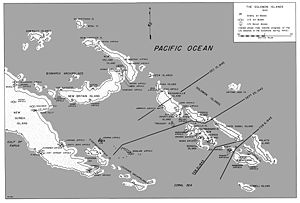
The Guadalcanal campaign, also known as the Battle of Guadalcanal and codenamed Operation Watchtower by American forces, was a military campaign fought between 7 August 1942 and 9 February 1943 on and around the island of Guadalcanal in the Pacific theater of World War II. It was the first major land offensive by Allied forces against the Empire of Japan.
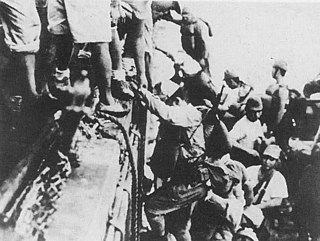
The Tokyo Express was the name given by Allied forces to the use of Imperial Japanese Navy ships at night to deliver personnel, supplies, and equipment to Japanese forces operating in and around New Guinea and the Solomon Islands during the Pacific campaign of World War II. The operation involved loading personnel or supplies aboard fast warships, later submarines, and using the warships' speed to deliver the personnel or supplies to the desired location and return to the originating base all within one night so Allied aircraft could not intercept them by day.
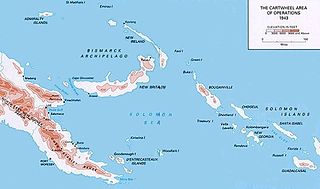
Operation Cartwheel (1943–1944) was a major military operation for the Allies in the Pacific theatre of World War II. Cartwheel was an operation aimed at neutralising the major Japanese base at Rabaul. The operation was directed by the Supreme Allied Commander in the South West Pacific Area (SWPA), General Douglas MacArthur, whose forces had advanced along the northeast coast of New Guinea and occupied nearby islands. Allied forces from the South Pacific Area, under Admiral William Halsey, advanced through the Solomon Islands toward Bougainville. The Allied forces involved were from Australia, the Netherlands, New Zealand, the US and various Pacific Islands.
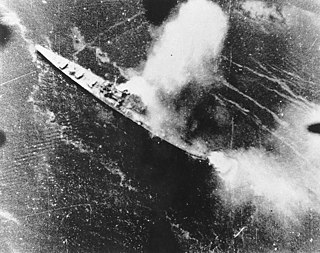
The bombing of Rabaul in November 1943 was an air attack conducted by the Allies of World War II upon a cruiser force at the major Japanese base of Rabaul. In response to the Allied invasion of Bougainville, the Japanese had brought a strong cruiser force down to Rabaul from Truk, their major naval base in the Caroline Islands about 800 miles north of Rabaul in preparation for a night engagement against the Allied supply and support shipping. Allied carrier- and land-based planes attacked the Japanese ships, airfields, and port facilities on the island of New Britain to protect the Allied amphibious invasion of Bougainville. As a result of the Rabaul raids, the Japanese naval forces could no longer threaten the landings. The success of the raid began to change the strongly held belief that carrier-based air forces could not challenge land-based air forces.

The New Georgia campaign was a series of land and naval battles of the Pacific Theater of World War II between Allied forces and the Empire of Japan. It was part of Operation Cartwheel, the Allied strategy in the South Pacific to isolate the Japanese base around Rabaul. The campaign took place in the New Georgia Islands in the central Solomon Islands and followed the Allied capture of the Russell Islands. The main fighting took place on New Georgia itself, although significant actions also took place around the island chain throughout the campaign.
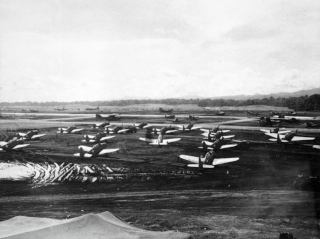
Cactus Air Force refers to the ensemble of Allied air power assigned to the island of Guadalcanal from August 1942 until December 1942 during the most heavily contested phases of the Guadalcanal Campaign, particularly those operating from Henderson Field. The term "Cactus" comes from the Allied code name for the island. In 1943, the Cactus Air Force was absorbed into AirSols, a joint command of Allied air units in the Solomon Islands.

The Bougainville campaign was a series of land and naval battles of the Pacific campaign of World War II between Allied forces and the Empire of Japan, named after the island of Bougainville. It was part of Operation Cartwheel, the Allied grand strategy in the South Pacific.
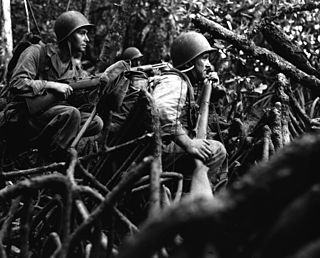
The Battle of Vella Lavella was fought from 15 August – 6 October 1943 between the Empire of Japan and the Allied forces from New Zealand and the United States at the end of the New Georgia campaign. Vella Lavella, an island located in the Solomon Islands, had been occupied by Japanese forces early during the war in the Pacific. Following the Battle of Munda Point, the Allies recaptured the island in late 1943, following a decision to bypass a large concentration of Japanese troops on the island of Kolombangara.
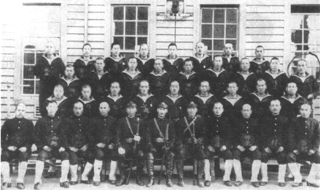
The invasion of Tulagi, on 3–4 May 1942, was part of Operation Mo, the Empire of Japan's strategy in the South Pacific and South West Pacific Area in 1942. The plan called for Imperial Japanese Navy troops to capture Tulagi and nearby islands in the British Solomon Islands Protectorate. The occupation of Tulagi by the Japanese was intended to cover the flank of and provide reconnaissance support for Japanese forces that were advancing on Port Moresby in New Guinea, provide greater defensive depth for the major Japanese base at Rabaul, and serve as a base for Japanese forces to threaten and interdict the supply and communication routes between the United States and Australia and New Zealand.
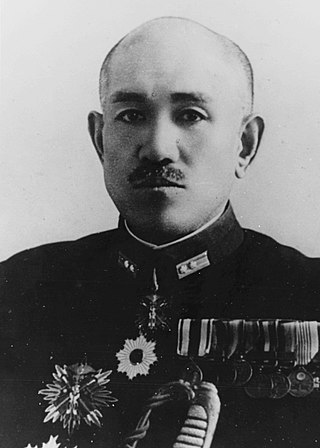
Jinichi Kusaka, was an admiral in the Imperial Japanese Navy during World War II. Fellow Admiral Ryūnosuke Kusaka was his cousin.
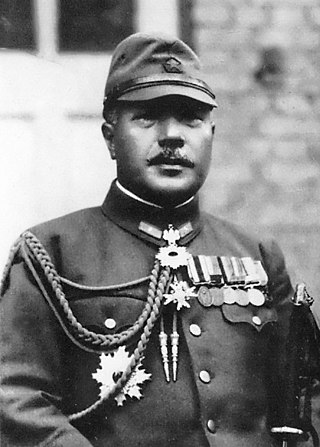
Minoru Sasaki sometimes referred to as Noburo Sasaki, was a Lieutenant General in the Imperial Japanese Army during World War II.

The Landings at Cape Torokina, also known as Operation Cherryblossom, took place at the beginning of the Bougainville campaign in World War II. The amphibious landings were carried out by elements of the United States Marine Corps in November 1943 on Bougainville Island in the South Pacific, as part of Allied efforts to advance towards the main Japanese base around Rabaul under Operation Cartwheel. Coming in the wake of Allied successes at Guadalcanal and in the central Solomons, the landings were intended to secure a beachhead with the purpose of establishing several bases from which to project air and naval power closer towards Rabaul, in an effort to neutralize the large Japanese force that had been established there.
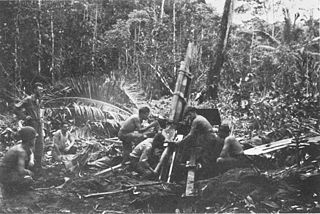
The Battle of Wickham Anchorage took place during the New Georgia campaign in the Solomon Islands during the Pacific War from 30 June – 3 July 1943. During the operation US Marines and US Army troops landed by ship around Oleana Bay on Vangunu Island and advanced overland towards the anchorage where they attacked a garrison of Imperial Japanese Navy and Army troops. The purpose of the attack by the US was to secure the lines of communication and supply between Allied forces involved in the New Georgia campaign and Allied bases in the southern Solomons. The US forces were successful in driving the Japanese garrison from the area and securing the anchorage, which would later be used to stage landing craft for subsequent operations.

The Drive on Munda Point was an offensive by mainly United States Army forces against Imperial Japanese forces on New Georgia in the Solomon Islands from 2–17 July 1943. The Japanese forces, mainly from the Imperial Japanese Army, were guarding an airfield at Munda Point on the western coast of the island that the U.S. wished to capture as one of the key objectives of the New Georgia campaign. After landing around Zanana on 2 July from Rendova, U.S. troops began a westward advance towards the airfield at Munda. Held up by difficult terrain and stubborn Japanese defense, elements of three U.S. regiments advanced slowly along the Munda trail over the course of two weeks. The slow progress resulted in a reorganization of the U.S. forces assigned to the drive, and preparations were made for a corps-level offensive, but before this could be launched, the Japanese launched a counterattack on 17 July.

The New Georgia counterattack was a counterattack on 17–18 July 1943 by mainly Imperial Japanese Army troops against United States Army forces during the New Georgia campaign in the Solomon Islands. The U.S. and its allies were attempting to capture an airfield constructed by the Japanese at Munda Point on New Georgia with which to support further advances towards the main Japanese base around Rabaul as part of Operation Cartwheel.

The Battle of Munda Point was a battle from 22 July – 5 August 1943 between primarily United States Army and Imperial Japanese Army forces during the New Georgia campaign in the Solomon Islands in the Pacific War. The battle took place following a landing by U.S. troops on the western coast of New Georgia from Rendova Island, as part of an effort to capture the Japanese airfield that had been constructed at Munda Point. This advance had become bogged down, and while the Allies brought forward reinforcements and supplies, the Japanese had launched a counterattack on 17–18 July. This effort was ultimately unsuccessful, and afterwards U.S. forces launched a corps-level assault to reinvigorate their effort to capture the airfield. Against this drive, Japanese defenders from three infantry regiments offered stubborn resistance but were ultimately forced to withdraw, allowing U.S. forces to capture the airfield on 5 August. The airfield later played an important role in supporting the Allied campaign on Bougainville in late 1943.
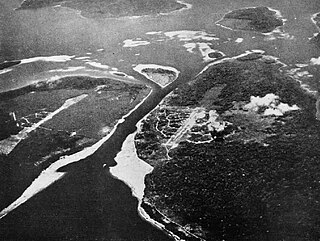
Between 9 March and 5 April 1942 during World War II, forces of the Empire of Japan occupied the islands of Buka and Bougainville in the South Pacific. At that time Buka and Bougainville were part of the Australian-administered Territory of New Guinea. A platoon of Australian commandos from the 1st Independent Company was located at Buka Airfield when the Japanese landed but did not contest the invasion.

Operation I-Go was an aerial counter-offensive launched by Imperial Japanese forces against Allied forces during the Solomon Islands and New Guinea campaigns in the Pacific Theater of World War II. Taking place from 1–16 April 1943, Japanese aircraft—primarily from Imperial Japanese Navy units under the command of Admirals Isoroku Yamamoto and Jinichi Kusaka—attacked Allied ships, aircraft, and land installations in the southeast Solomon Islands and New Guinea. The goal of the operation was to halt the Allied offensives to give Japan time to prepare a new set of defenses in response to recent defeats in the Guadalcanal campaign and in New Guinea at Buna–Gona, Wau, and the Bismarck Sea.
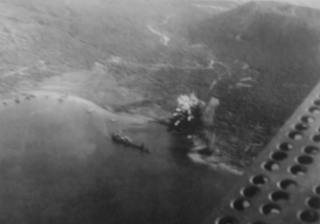
The neutralisation of Rabaul was an Allied campaign to render useless the Imperial Japanese base at Rabaul in eastern New Britain, Papua New Guinea. Japanese forces landed on Rabaul on 23 January 1942, capturing it by February 1942, after which the harbor and town were transformed into a major Japanese naval and air installation. The Japanese heavily relied on it, using it as a launching point for Japanese reinforcements to New Guinea and Guadalcanal. Throughout the Solomon Islands campaign, neutralizing Rabaul became the primary objective of the Allied effort in the Solomons.

The Japanese occupation of the Solomon Islands was the period in the history of Solomon Islands between 1942 and 1945 when Imperial Japanese forces occupied Solomon Islands during World War II.
